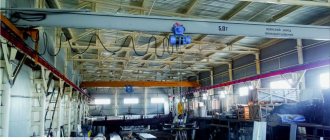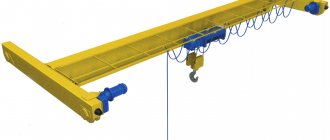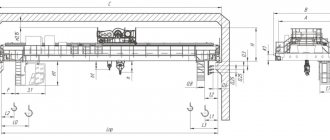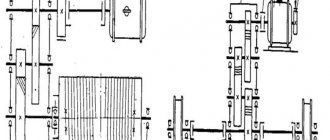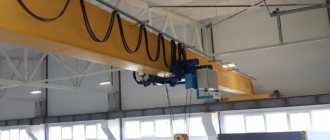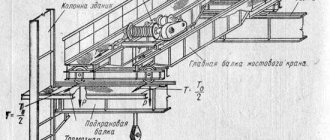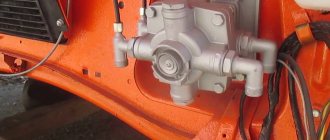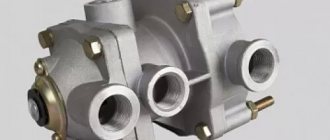An overhead crane is a lifting mechanism that moves along a crane runway. The purpose of the overhead crane is to perform loading and unloading operations in the workshops of industrial enterprises, in open and closed warehouses, as well as installation areas.
The type of overhead crane depends on the set of design features of the crane equipment. This is the type of crane runway and span structure, as well as the type of drive of the lifting mechanism and load-handling device. Specific parameters of lifting and transport equipment are selected based on the characteristics of the site, the expected intensity of work and the characteristics of the load.
Classification of overhead cranes
By crane track type:
The crane runway varies depending on the design of the crane; in the case of a suspended crane, beams are used, and for a support rail or square. A lifting device is installed or suspended on the crane bridge, which ensures lifting of the load and also has the ability to move along the crane bridge.
- Support.
The role of the crane runway is played by rails mounted on metal or concrete supports. Such cranes are more expensive, but have a high level of reliability and ease of operation. Their lifting capacity and span length are greater than those of overhead cranes. - Suspension.
I-beams fixed to the ceiling of the building act as a crane runway. A bridge with a crane trolley is suspended from their lower shelves, so that the running wheels rest on the inside.
By type of lifting mechanism drive:
- Electric.
These are powerful and easy-to-operate lifting mechanisms designed to serve a large flow of cargo. Electric motors act as the power unit, and hoists serve as lifting mechanisms, and in the case of heavy duty and loads, winches. - Manual.
Manual overhead cranes are installed in workshops and warehouses with limited space. They do not require connection to the electrical network; a chain hoist is used as a lifting mechanism. Such crane equipment is cheaper and easier to maintain.
By bridge type:
- Single beam.
This type of equipment is also called a beam crane; its bridge is made of an I-beam supported by two end beams. Such lifting and transport mechanisms have a lifting capacity of up to 10 tons and are optimally suited for use in areas with limited space. - Double beam.
Designed to serve a large flow of cargo and can have a lifting capacity of up to 100 tons or more. Double-girder overhead cranes have a longer span than single-girder cranes and can be equipped with a mobile or stationary operator's cabin.
Double Girder Electric Support Crane
Single girder overhead electric crane
According to the type of load-handling device:
- Kryukova.
This is a universal and most common type of overhead crane. The load is secured with slings and grips, and for transporting bulk and liquid materials, a special vessel or bucket is hung on a hook. - Grab.
It is a special bucket designed for transporting coal, crushed stone, timber and other bulk and piece materials. When the jaws of the grab for bulk materials are closed, they form a bucket, and for lumber they are made in the form of claws. - Magnet.
Such a load-handling device is intended for transporting steel and cast iron products, as well as metal scrap or shavings. It is an electromagnet hung on a hook and connected to the network.
Hook
Grab
Magnet
Control Features
The crane mechanism is controlled using two handles: the left one is for lifting control, and the right one is for the movement mechanism of the trolley and crane. The handle for controlling movement is installed vertically and moves in the plane of movement of the trolley and crane. The second one moves in a vertical position in the plane of movement of the load. The “ Stop ” position of the handles is fixed so that it is possible to switch them with a slight movement of the hand. The brakes are controlled by pedals. Push-button switches perform emergency braking. They are located to the left of the crane operator.
Remote controls can be controlled by buttons. When installing the pedal system control, there should be a distance of 2-4.5 meters between them, from the back of the chair to the pedal axle - 9.3 meters, the angle of movement of the pedal is 70 degrees.
The controls should be positioned so that, if possible, the working movement is reduced to the movement of the hands and forearms, while allowing shoulder movement of the joint as an exception.
How does an overhead crane work?
The main feature of an overhead crane is the movement of cargo without the use of additional equipment. The mechanisms of such cranes can be electric drives or manual power, depending on the type ordered. Traditionally, a sling system is used to grab the load, but depending on the specifics of the work, the capabilities of the crane can be expanded by installing a grab or a powerful electromagnet.
Brake system
Stopping the overhead crane is ensured by a disc brake; this is one of the most reliable and effective braking systems. It works even in the absence of mains voltage and meets basic industrial safety requirements. The integrated design of brake motors allows for reliable and compact drive systems.
Lifting mechanism
The load lifting mechanism is suspended from the span using a running carriage or mounted on a crane trolley in a double-girder structure. It consists of a gearbox, coupling, drum, rope guide, electric motors, hook and control unit. For high load capacity or heavy duty conditions, an expanded type lifting mechanism, commonly known as a winch, can be used.
Gearboxes
The overhead crane uses two types of gearboxes to ensure the movement of the bridge and trolley. As a rule, these are worm or cylindrical gearboxes. Such mechanisms are reliable, durable and easy to maintain.
Crane tracks
There are two types of crane runway fastening – support and suspended. The support type involves attaching a supporting element (solid square, rail) to power beams, steel or concrete. The end trolleys of the overhead overhead crane are fixed to the bottom of the beam. The most common type of this equipment is electric overhead cranes.
Depending on the project, support-type overhead cranes are installed on various types of crane rails or solid squares. A solid square is a more economical and simpler solution; this technology came to us from Europe and has been used in the lifting equipment market for several years, but for cranes with a lifting capacity of over 20 tons it is necessary to use a rail. Overhead overhead cranes move along fixed I-beams of different sizes, depending on the load on the floor of an existing building or a separate crane runway.
Electrical equipment
All electrical equipment of an overhead crane is divided into main and auxiliary. The main one ensures the lifting and movement of cargo to the unloading point, and the auxiliary one increases the safety of operation and makes it more comfortable.
- the main electrical equipment includes electric motors, as well as a control and monitoring circuit for the operation of the crane;
- auxiliary electrical equipment - these are heating, lighting, sound alarm devices, as well as measuring equipment.
The overhead crane is powered using a trolley busbar, scallop or cable system.
Crane trolley
The load trolley is used only on double girder types of cranes and is used to move the load along the bridge. It is a rigid steel frame on which drives and electric motors of the movement mechanism, power supply and safety systems are installed.
Overhead Crane Control System
The overhead crane is controlled using a pendant control panel or radio control. If a radio control is installed on the crane, the pendant control must be left; if done differently and only the radio is left, then even a 2-ton overhead crane will be subject to supervision and will require registration with the necessary authorities. In some cases, the crane can be controlled from a stationary cabin; more often this is necessary when working with a grab or a magnet; there are also mobile cabins, they move together with the lifting mechanism and are attached to the crane trolley. Installation of a mobile cabin is possible only on a double-beam structure.
On a note!
The person who operates the crane using a pendant or radio control is called an operator, or in the case of a fixed or mobile cab, a crane operator.
Crane operator workplace
Another type of panoramic cabin is equipped with a folding platform for access from the workplace. To enter the cabin, a rotating platform and a platform are installed around it, which is connected to the rotation mechanism of the worker’s chair (this is necessary for wiping the cabin glass).
The seat is located in the middle of the cabin and is connected to a vertical shaft, which rotates in a bracket fixed to the cabin floor. The shaft is connected through a worm gear to the electric motor of the rotation mechanism. Control is performed by two buttons, which are mounted on the armrest of the chair.
The height of the chair above the floor should be 0.4-0.5 meters, the height of the backrest should be 2.4-2.6 meters. The chair should be semi-rigid, with armrests, and be able to adjust the middle position forward and backward, up and down.
The footrest and armrests should be adjustable in height, and the backrest should be able to adjust the angle of inclination. The most convenient are remote control chairs, which have columns with controllers and a crane operator’s chair located between them.
This is what a crane operator’s workplace looks like
Very common power controllers with smaller overall dimensions: they make it possible to eliminate the need for command controllers with their expensive and bulky magnetic stations required for operation.
How to learn more about the types, features and operating principle of an overhead crane
If you need more information about overhead cranes, request a free consultation directly on this website. Our specialist will call you back, answer all your questions, and, if necessary, help you select lifting and transport equipment to solve specific problems. Get comprehensive information about the types of beam cranes and other types of crane equipment.
Our specialist will help you choose the optimal type of overhead crane and accept an order for its production. Our office is located in Moscow, but we carry out installation and maintenance work on material handling equipment in any region of the Russian Federation and neighboring countries. Contact us right now!
Stabilization of the electromagnetic brake system
Brake adjustment begins with the crane operator setting the standard armature stroke. To do this, the nut is separated from the washer, and the square sharpening, supported by a wrench (to ensure a stationary state), rotates until the stroke of the electromagnet armature is half the nominal income.
Electromagnetic brake device
Next, to fix the end spring, the nut is screwed with a washer, and the rod is rotated by the square sharpening. The spring is pressed until the braking torque is reached.
Repairing hydraulic brakes involves removing the pusher rod. At this time, a block of wood or metal should lie under the lever on the pusher cover. Next, remove the hinge pins from the pad mounting and direct them to the friction surface of the pulley to a position in which the pad extends through the gap between the pulley, rod and brake lever.
Purpose and application
The overhead crane devices in question are used in large enterprises, sometimes in small auto repair shops. The machines are used for various loads in the foundry industry, mechanical engineering and construction work, in the oil refining and chemical industries.
Purpose of the overhead crane:
- lifting loads in indoor areas and carrying them;
- work with bulk goods, for which models with grabs are used;
- carrying out lifting operations without current;
- operations at closed and open sites.
Overhead cranes help large enterprises operate, which allows them to conquer new markets.
